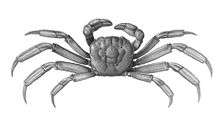Discoplax longipes
Discoplax longipes is a species of terrestrial crab. It is found in karstic caves on Pacific islands[2] and ranges from the Loyalty Islands to French Polynesia (the Guam population was recognized as a separate species, D. michalis, in 2015).[3] Mating occurs in the caves, after which the females migrate to the sea to release their fertilised eggs.[4] The genus Discoplax was for a long time synonymised with Cardisoma, but was resurrected in the late 20th century.[2]
| Discoplax longipes | |
|---|---|
 | |
| Scientific classification | |
| Kingdom: | |
| Phylum: | |
| Subphylum: | |
| Class: | |
| Order: | |
| Infraorder: | |
| Family: | |
| Genus: | |
| Species: | D. longipes |
| Binomial name | |
| Discoplax longipes | |
| Synonyms | |
|
Cardisoma longipes A. Milne-Edwards, 1867 | |
References
- Peter Davie (2010). "Discoplax longipes". World Register of Marine Species. Retrieved October 18, 2010.
- "Discoplax longipes". SANTO 2006. Institut de recherche pour le développement. September 12, 2006. Archived from the original on November 22, 2006. Retrieved October 18, 2010.
- Peter K. L. Ng & Hsi-Tse Shih (2015). "The land crabs of the Discoplax longipes A. Milne-Edwards, 1867 species group, with description of a new species from Guam (Crustacea: Decapoda: Brachyura: Gecarcinidae)". Zootaxa. 3980 (3). doi:10.11646/zootaxa.3980.3.3.
- Richard G. Hartnoll (2010). "Chastity belts and planktotrophic larvae: constraints on gecarcinid reproductive behaviour". In Peter Castro; Peter J. F. Davie; Peter K. L. Ng (eds.). Studies on Brachyura: A Homage to Daniéle Guinot. 11. pp. 153–171. ISBN 978-90-04-17086-5.
This article is issued from Wikipedia. The text is licensed under Creative Commons - Attribution - Sharealike. Additional terms may apply for the media files.